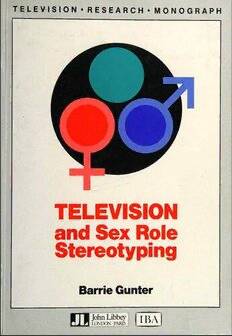
Television and sex role stereotyping PDF
Preview Television and sex role stereotyping
T E L E V-1S I O N • R E S E A R C H • M O N O G R A P H TELEVISION and Sex Ro.le Stereotyping Barrie Gunter TELEVISION and Sex Role · Stereotyping TELEVISION and Sex Role Stereotyping Barrie Gunter Research Officer Independent Broadcasting Authority John Libbey j I l~A j LONDON· PARIS British Library Cat.aloguing in Publication Data Gunter, Barrie Television and sex role stereotyping. - (1BA research monogTaph) . . I. Sex roles - Public opinion 2. Sex in television 3. Television - Social aspects l. Title II. Series 305.3 HO 1075 ISBN 0-86196-095-S ISBN 0-86196-098-X Pbk Published by John Libbey & Company Ltd 8Ml4 Bondway, London SWB ISF, England (01) 582 5266 John Libbey EW'otext Ltd 6 rue Blanche, 92120 Montrouge, France (I) 47 35 85 52 © 1986 John Libbey & Company Ltd. All rights reserved. Unauthorised duplication contravenes applicable laws, Typesetting in Rockwell by EE Owens & Co Ltd, London SE15 4AZ Printed in Great Britain by Whitstable Litho Ltd, Whitstable, Kent Contents Chapter 1 Introduction 1 Chapter 2 Portrayal of the sexes on television 5 Adults' programmes 5 Children's programmes 16 Advertisements directed at adults 19 Advertisements directed at children 25 Chapter 3 Perceptions of the sexes 27 Children's perceptions 30 Adults' perceptions 34 Chapter 4 Social effects of television and sex stereotyping 45 Research with adults 46 Research with children 51 Chapter 5 Counter-stereotyping through television 63 Research with adults 66 Research with children 67 Chapter 6 Final remarks 75 References 81 Chapter I Introduction A fundamental aspect of human social development involves learning to behave in ways deemed socially and culturally appropriate for one's own sex. This socio-cultural normalising of displayed, acceptable characteristics and behavioural roles for males and females has been found to develop among children at an early age (Fauls and Smith, 1956) and may influence a child's choice of activities as early as nursery school (Fagot and Patterson, 1969). Spence, Helmreich and Stapp (1975) demons trated that stereotyped beliefs were significant factors affecting how people perceived themselves and have an effect particular ly on levels of personal self-esteem. With the emergence of the women's rights movement, sex role stereotyping has been identified as a source 0f restrictive practices which limit the number and range of roles, opportuni ties and prospects open to women socially and more especially in professional and occupational spheres. One argument is that the acceptance of women into certain professional roles is restricted to a significant degree by prevailing stereotypes and images of women in society. The observation of male and female models in the child's environment has been postulated as a major source of sex-role information (Kohlberg, 1966; Mischel, 1970). The developing TELEVISION AND SEX ROLE STEREOTYPING child has two principal sources of models - the home and school environments and the mass media and chiefly the audio visual media. Research which has examined the way the sexes are portrayed on television has noted a pronounced stereotyping of women in adult daytime, peak-time and children's program ming and in advertisements (see Butler and Paisley, 1980; Cathey-Calvert, 1983; Durkin, 1985a). This has led write;s interested in the elimination of sex stereotypes to request an enforce balance in the portrayal of social and occu ational rot s w ch have tradit-i-0n - ~.esented as exclusively-or i:2i:.eoominantly assooiated--with-one-er-ethe.~ex_(Busby, 1975). According to the conclusions of this work, stereotyping has been characterised by two principal features: firstly, there is a gross under-representation of women in action-drama program mes in terms of actual numbers relative to the presence of men, something which has been referred to by one writer as the 'symbolic annihilation of women' (Tuchman, 1978). Secondly, even when women do appear, they tend to be portrayed only in a very narrow range of roles. In television's fictional life, women tend to be most often found in the home, and much less often at work. Television has also been accused of portraying women as incompetent, especially when they appear in anything other than marital or familial roles. American researchers have observed that this is reflected particularly in the extent to which female characters in American peak-time television are on the receiving end of violent attacks. One major series of US research studies has indicated that whenever women in television drama prog rammes are involved in violence, they are more likely than men to be helpless victims (Gerbner, 1972; Gerbner and Gross, 1976; Signorielli, 1984). Thus, Tuchman (1978) has arguPd. that televi sion plots symbolically denigrate women, so that even when they are portrayed in leading roles and outside the home, they are surrounded and continually rescued by male colleagues. The serious implication of this apparent tendency towards sex-role stereotyping on television lies with the possible impact this content may have on the public's beliefs about men and women. The greatest concern is for the effects on young children at the stage when they are just beginning to learn sex appropriate attitudes and behaviours. Several studies have indicated that a heavy diet of television viewing at an early age is 2
